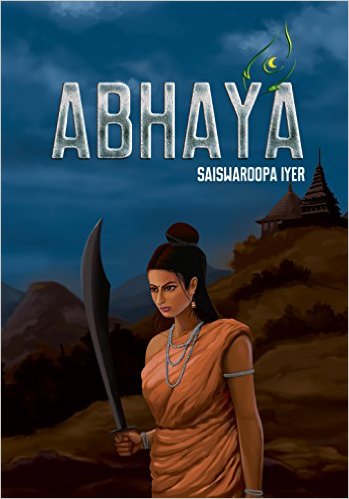Abhaya by Saiswaroopa Iyer is a historical fiction. Amish Tripathi has inspired a whole generation of Indians to explore their own history, mythology, and culture hidden in ancient epics and the millions of stories therein. Ancient Indian literature lets you pick up a character and built a new story around it. You can use the already existing characters to tell your story. Or you can invent new characters to build your story. You can pick up the old characters and set them in your chosen time and space. And ask them to solve current day socio-political issues. Author Saiswaroopa Iyer has attempted to do something like this by picking up some characters from Mahabharata, choosing a timeline that also fits in the time of Mahabharata around the time when Indraprastha was being set up and Rajsuya Yagna was in process.
Saiswaroopa Iyer goes ahead and invents her own characters and an imaginary kingdom somewhere close to present day Ahmedabad or Vadodara. Her protagonist is a feisty girl – Abhaya. The name literally means the fearless. The girl is the heiress to her father’s kingdom. And takes political decisions for her father’s kingdom. She is in love with Krishna – who was not in love with him at that age. I felt that through this character it is author’s love for Krishna that shines through – her faith in him being there and taking care of all tricky situations. Have we not read about all those episodes in Mahabharata and Bhagwad Purana where he appears out of nowhere to rescue women? All these episodes make us women fall in love with him.
The story moves across the ancient geography of India. Though the author has confined her story to current day India. From east to west it moves from Dwarka to Guwahati that was then known as Kamarupa. The story begins in western India and with the protagonist moves to North and then North East. Through another minor character, there is a glimpse of the south of Vindhyas. However, what I missed was the intimate descriptions of the iconic places like say Kashi. All these places have had a distinct character even during the epic times, but the author failed to point that in the book. Her description of the Kamakhya temple in Guwahati is, of course, her imagination. But Kashi, where she attempts to paint the place, lacks the first-hand knowledge of the ghats. Similarly, her description Mathura and Braj Bhoomi do not convey the essence of the place.
There is an ideological conflict between Aryans and Shaktas – the followers of Shakti or the Tantric, that the story tries to highlight. However, in the garb of this difference though Saiswaroopa Iyer tries to address the current day issues. Especially the issues related to women. She brings out the issue of female infanticide, rampant rapes in the garb of religion and the general ill-treatment of women. Through her strong protagonist Abhaya, she tries to somewhere say that ‘Women are equal and they can do everything that a son or a man can’. At the same time, by making her dependent on Krishna at every step, she contradicts her own hypothesis.
However, if you interpret it as an example of inter-dependence – that the story nowhere touches upon – it could have been an interesting angle. Personally, I opine that we need to bring out the fine balance of interdependence between the genders to let go of the ever-widening divide.
What I liked about the book is picking up the known and then extending it from there. I also liked the storytelling technique to use mythology to address present-day issues. In fact, this is how the ancient Indian literature was constantly fine-tuned over the ages. In this respect author’s attempt is laudable.
Language is simple. But I found it too contemporary for a story set few thousand years ago in time. Words like Supply, Demand, Technically etc that clearly belong to an industrial age stand out like a misfit. I was constantly distracted by the modern day jargon. When you write historical fiction, choosing your language is very important; your language must keep the reader rooted in that era. Some authors who write only about a certain era excel at this.
There is also a lot of incoherence in the language. At one place she mentions Map of Bharatvarsha – probably unaware of the fact that there were no maps of India till medieval ages. At least not the way we know maps today. Editing could be better, but I am told by the author that the next edition has taken care of a lot of editing errors. The pace is uneven. Sometimes it moves too fast and sometimes it just stops – usually at the intended romantic scenes between Abhaya and Krishna.
Overall, an interesting read.
You may buy this book – Abhaya by Saiswaroopa Iyer at Amazon.









